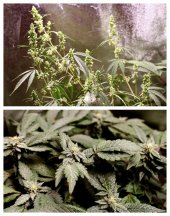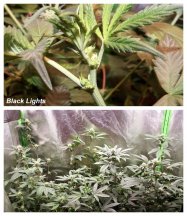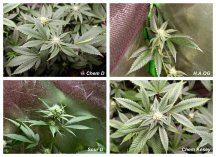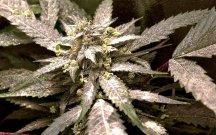@Schwaggy P was wondering if you could do a write up on plant structure?

When you hear “structure”, usually it is a catchall term causally used to refer to a plant’s “look” or the integrity of branches. I like to think of structure as the amalgam of individual observable constituent components of the plant.
Structure usually refers to pre-flower characteristics, but structure is something to continue considering through the entire cycle: stretch, branch strength under pressure, specific bud characteristics (
this write-up will focus on pre-flower structural considerations).
The amount of consideration given to plant structure is wholly dependent on the goals of the grower. If you are a grower looking for a potent plant that works well in your SCROG setup, you probably aren’t going to spend too much time noting the serration pattern of the leaves. If you are a breeder trying to benchmark the heritability of a set of traits and need to establish whether unrelated phenotypic expressions are linked as they pass along to subsequent generations, you’ll be taking note of the serrations along with vein striations, leaf texture, etc. If you have a cut/cross and want to verify it against parent plants, you’ll want as much observable info possible to make a match.
The most important and most difficult part of any hunt/assessment of plants is to know what you are looking for, or more specifically, what you want to find in any set of characteristics. Ask yourself,
- What motivated me to grow these seeds?
- What characteristic(s) was I envisioning when considering popping these seeds?
- What set of traits would I consider keeper quality?
- Am I trying to find which parent this leans to?
- What type of plant would work best in my setup?
- What traits do I want to see in the progeny of this plant?
If you can answer these questions and prioritize the individual traits, you have a better understanding for what you are looking. Whether you are just assessing new plants from seed, selecting breeding stock, or figuring which parent a cross leans to, having these answers can better guide the effort.
You could only really care about the final smoke effect, and in that case, structure is mostly irrelevant.
One grower’s cull is another grower’s keeper
Structural Components
INTERNODES
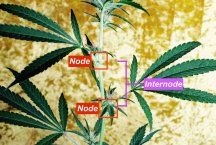


The integrity of your plant framework is instrumental in the ability to support itself later in flower. Plants with thinner stems tend to need more support throughout maturity(pic 6), while thicker more robust stems can comfortably sustain massive bud growth independently (pic 7).
If you were looking for a plant to max out in a SCROG, you would skew toward the thinner, floppy stemmed plants to more easily weave through your screen. If you prefer to keep your plant support low maintenance, stronger stems will be more desirable.
BRANCHING

Your plant’s tendency to push out secondary tops that adds to the footprint, yield, and need for support is the branching quality. Some plants will grow as one main stalk with little to no side branching (
pic 8). This would be advantageous in a SOG setup as lateral growth is limited. Conversely, a plant more adept at spitting out side growth will respond well to topping techniques for medium sized bushes (
pic 9).
In veg, how a plant responds to topping can tell you how reluctant it is to branching. Sometimes, you don’t get an appreciation for a pheno’s ability to branch until the stretch.
PETIOLES

Petioles are the stems that connect the leaf to the node of the plant. These come in all sizes and can impact your plant footprint and light penetration. Shorter petioles give the plant a narrow silhouette, great for packing in plants to a space; but can reduce the amount of light that can penetrate the upper canopy (
pic 10). Longer petioles demand more square footage but allow far more light into the interior of the plant (
pic 11).
A goldilocks balance between the two extremes can offer you the best of both worlds while sidestepping the brunt of the downsides.
LEAF BLADES
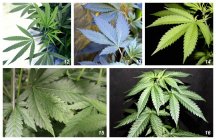
- Width
- Taking note of the leaf blade width can help give you an idea about the phenotype’s leanings to the parents and genetics more generally (pic 12,13).
- Serration
- Leaf serration can give you an idea about which parent is expressing in the leaves. Some plants develop a double serration and sporadic double serration (pic 14). Some leaves can have deep serrations that give a buzz saw look to the leaves, while others are shallow and less obvious.
- Variegation
- If your plant expresses variegation, you have a peculiar trait that can give insight about which parent expresses and can be used as a marker in breeding (pic 15).
- Texture
- The individual blades can have different surface character, being smooth or like gator-skin. Thicker leather-like leaves that have rougher surfaces can offer more surface area and a tougher protection against pests (pic 16).
- Number
- The number of blades per leaf can change as the plant develops. Some can start with 3-blades and develop 5-blade leaves (pic 17). Noting the number of blades can also help in plant ID comparison.
- Size Distribution
- The relative sizes of the leaf blades can also help ID plant leanings and establish trait heritability. Some blades have a more evenly distributed leaf blade surface area (pic 18), while others can take on a 1:3:1 arrangement (pic 19).
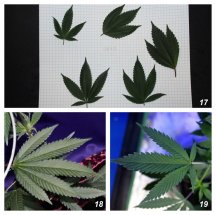
There are some other traits that are flower specific and more in depth for geeking out/breeding (
leaf veins, angles of blades, petiole tasting). This should be a decent intro to structure and help spot the differences in phenotypes.

